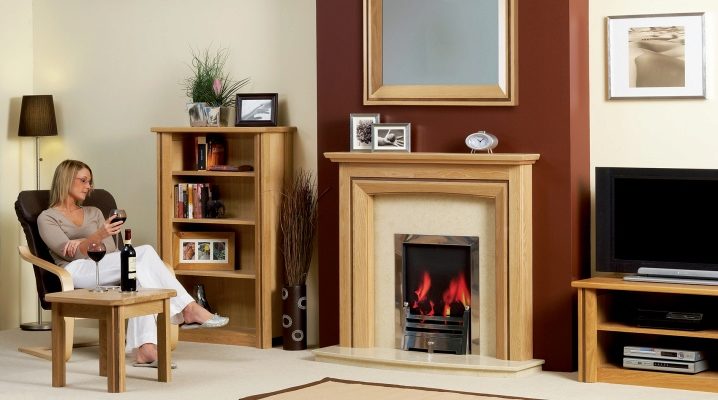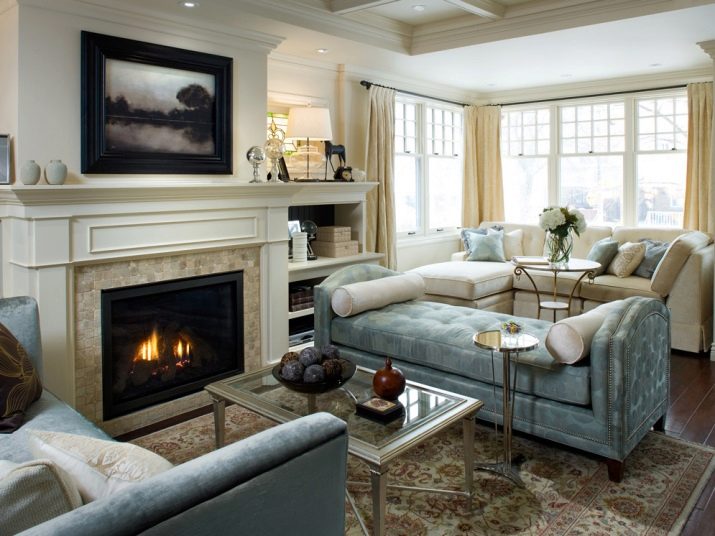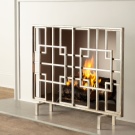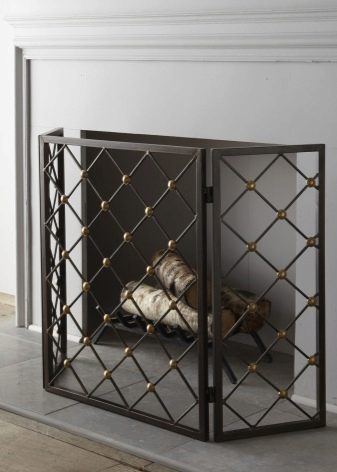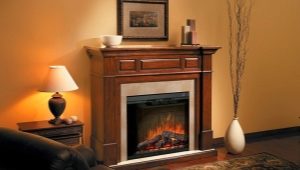Fireplace screen
Fireplace screen is a protective device that prevents sparks and embers from burning firewood on the floor. For an apartment electrofireplace the screen is required if there are small children in the house, and the fireplace works in the heating mode. He will not let the child get burned by hot items.
Kinds
Screens for fireplaces are built-in and external. Built-in screens are mounted in the fireplace in the process of its calculations. Contrary to popular belief, the built-in screen is not set once and for the whole life of the fireplace (this is how the doors for stoves are installed). Only supports are mounted in the fireplace for fixing that part of the screen, which serves as protection against heat (the thermal protective collapsible screen is hung separately). If you did not take care to make the built-in screen during the order of the fireplace, you can do it later, then the support will be laid out next to the firebox. To do this, it is necessary to make insulation on the floor, in front of the firebox, to lay out brick bollards up to the middle of the firebox (this is somewhere from 30 to 50 cm in height).During the display, refractory fasteners-corners are mounted into the cabinet, on which the screen itself is then hung.
There are built-in forged mesh screens that have a decorative function. However, when the fireplace is heated, fireproof glass is inserted inside to protect the room from sparks.
External screens are usually made composite. The most popular tricuspid composite screens. They are three tall frames on a metal frame, fastened together by loops. Refractory glass is placed inside the frame. When the need for protection disappears, the frame “collapses” and leaves aside.
If the fireplace is large, then use composite screens on separate frames. Screen frames are placed overlapping next to each other to partially overlap each other.
Mesh screen is used for open fireboxes. It is very convenient if there is not enough space in front of the fireplace, because the grid can stand almost close to the fire. It has small cells and prevents coal from falling out of the fireplace.
Material
Fireplace screens are made of metal, glass, mesh, superisole, and even heat-resistant tiles.
The metal screen can be made of bronze, iron, copper. Forged screens can be of any shape and size: a single canvas, composite, composite hinges. This type of screen includes a fine mesh. Forged or prefabricated metal screen can be used both by itself and as a framework for glass.
The glass screen has an undeniable advantage - it reliably protects from sparks and opens absolute visual access to the fire. Glass screens can be made of heat-resistant ceramics or tempered glass. Heat-resistant ceramics withstands direct contact with the flame (safe temperature of 760 degrees), but is not impact resistant. Toughened glass is impact resistant, but the maximum allowable heating temperature is 300 degrees, so it is installed at a distance from the firebox.
The glass screen may not have a frame at all, if the glass has a bent shape, then it stands by itself. Usually make holes for fingers for easy carrying.
Superisol or calcium silicate is an excellent material for the fireplace grate. It has a low thermal conductivity and is often used when working with smelting furnaces.Choosing a screen from super isola, you should clarify what material was used in the work: German, Belgian and Danish - good, Chinese - bad, its composition and properties are not fully understood, and it can be dangerous for health and for the house.
Superdisol is strong enough, it is easily painted with fire-resistant paints (if you need to change color), you just need to make a screen yourself from it, you do not need special tools, standard joinery is enough. This is one of the best insulation materials.
Scenery or necessity?
Fireplace screen is a rare element that simultaneously performs two functions: decorative and protective.
Even if the fireplace is made according to the rules, if the base is insulated, it is below the floor level, and a curb 30 cm high around the firebox at a distance of 50 cm, it is still a potential threat to the safety of the owners. Especially if the house is inhabited by small children and pets. Animals like to sleep near a heat source and often lie down directly near the open firebox. If the fireplace is not wood-burning, then nothing terrible will happen, and if it is heated by firewood, then sparks caught on the wool can lead to the death of the animal and the occurrence of a fire.And for small children, even an electric fire is a danger - a child can get burned on the glass if the fireplace works for heating. Therefore, the first function of the screen - protection from flames and heat.
- The second function of the screen is to increase the efficiency of the fireplace. Wrought iron grilles heat up from the flame and give the heat to the room very well, they are often used in the winter to get additional heating with the same fuel consumption (biofuel, electricity or firewood).
- The third, important function - aesthetic. Fireplace screens are able to turn even the most ordinary hearth into a masterpiece of design art. Very beautiful screen looks made of glass, made in the form of stained glass. It allows you to bring to life a little fairy tale of the Middle Ages, providing beautiful optical effects and color play.
Installation
If you do not plan to heat the fireplace in the summer, it is best to choose an external screen for it. Such a screen can be made independently. For manufacturing, you will need tubes or steel profiles for the frame, fittings for fasteners of the protective screen itself, material for making the protection - mesh or glass, hinges (if you want to make a folding screen).
The composite screen from different frames that are not interconnected is the easiest to manufacture. The most difficult part - the manufacture of supports. It is necessary to make them weighted and stable so that a random touch does not knock the screen on the floor. Often, a metal sheet or a super-ash sheet about 30 cm wide and 15 cm longer than the screen frame is used for this. It performs the role of a pedestal, to which supports are fixed on both sides.
The simplest frame is made in the shape of an inverted "T" of two pieces of steel pipe. The height of the vertical support should not be lower than ¾ from the height of the firebox. This height is optimal for protection against sparks and makes it easy to put firewood in the fireplace without disassembling the hot structure. The horizontal pipe is the support. If you need to frequently remove the structure, you can use a non-combustible fabric instead of a solid screen, attaching it from four ends to the stands. Such a screen is easy to twist and put behind the cabinet or removed on the mezzanine.
